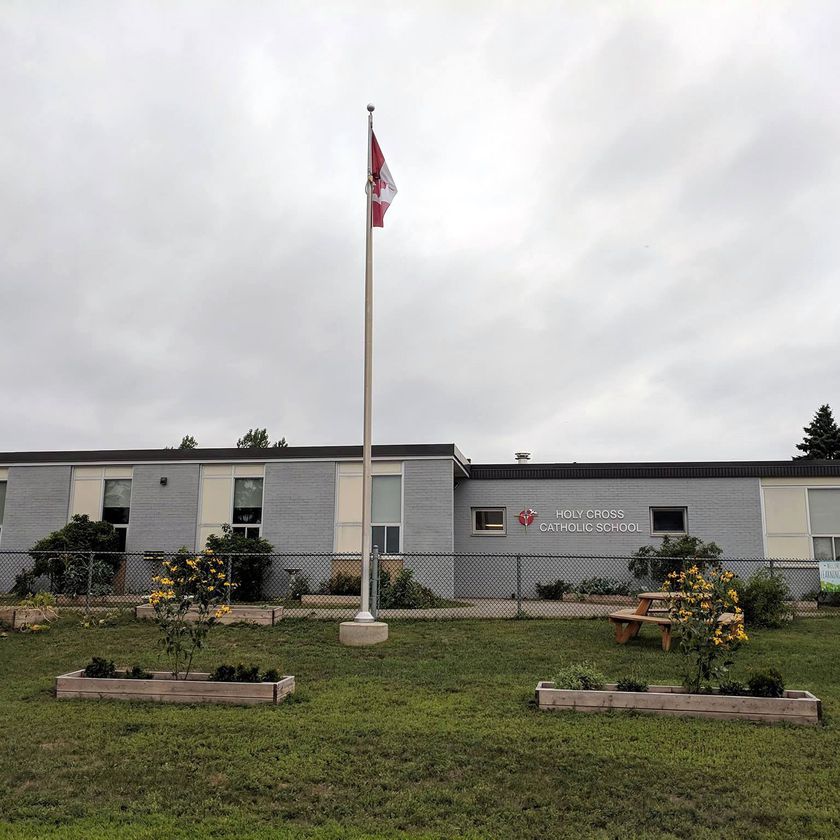Holy Cross Catholic School in Kemptville is shown here. Photo credit: Catholic District School Board of Eastern Ontario/Facebook
KEMPTVILLE – Classes resumed on Monday after the Catholic elementary school here closed its doors following a COVID-19 outbreak last week.
The good news came as the regional case count rose by three over the weekend – as did the number of people who have recovered.
Holy Cross Catholic School closed for the day on Friday after officials identified two confirmed cases of COVID-19 on site – the first school-based cases in the region – but promptly reopened after a thorough investigation.
“Contact tracing has been completed by the local health unit and no new cases of COVID-19 have been reported at the school,” the Catholic District School Board of Eastern Ontario wrote on social media.
“We are continuing to work closely with the local health unit and we will notify parents should the circumstances change.”
Of the two cases, one was confirmed to be a staff member and one was a student, according to provincial data.
The school closed for a day because testing and isolation requirements caused a staff shortage, the school board added. This prompted safety concerns, forcing them to close for a day.
According to the Leeds, Grenville and Lanark District Health Unit, an outbreak is defined as “two or more lab-confirmed COVID-19 cases in students and/or staff in a school” that can reasonably be linked to each other.
Susan Healey, a spokeswoman for the health unit, said they have not received any more positive test results from anyone at the school since the initial cases were announced, but they’re still awaiting results for some close contacts of the people who tested positive.
Those people will stay home while they wait for their results, she said.
“In a school, everyone who is identified as a case or a high risk contact of a case is excluded for 14 days,” Healey said on Monday.
“High risk contacts are recommended for testing. They will also remain on isolation for the full 14 days, even if a negative result is obtained, to ensure nothing further develops.”
Provincial guidelines say anyone who tests positive for COVID-19 must isolate for 14 days after the onset of symptoms – or 14 days after a positive test if there are no symptoms – as long as there is “no fever and symptoms have been improving for three days,” Healey added.
The Upper Canada District School Board also confirmed late last week a person at Chimo Elementary School in Smiths Falls tested positive for the virus, the first case in the region’s largest school board.
The letter from the health unit’s Dr. Paula Stewart said they had been in contact with and isolated all students and staff that may have had “high risk exposure.”
The school did not close and an outbreak was not declared. Provincial data indicates the patient is a student.
“This is the first positive case of COVID-19 for our school board and Chimo was able to provide all the necessary information public health needed to do their contact tracing,” school board superintendent Dave Coombs said in a statement.
“Chimo staff take every precaution to ensure the safety of our students, and our students are very good at following the heightened health and hygiene practices that have been put in place. The safety of our students and staff remains a priority for us.”
The news came as the province announced 700 new cases of COVID-19 on Monday – the highest one-day increase ever recorded. Health Minister Christine Elliott said 60 per cent of Monday’s cases were in people under the age of 40.
Locally, the health unit reported three new cases on Monday but the total sits at 11 active cases because three other people also recovered from the virus.
The number of total cases rose from 378 to 381, while the number of patients who have recovered rose from 315 to 318. Since the start of the pandemic, the area has seen 52 COVID-19 deaths.
All 11 active cases are people in the community, as opposed to health-care workers or residents of seniors’ facilities. None of the current patients are in hospital.
The health unit was reporting six active cases in Grenville County, three active cases in West Leeds, and two cases in Lanark.
The numbers are based on data as of 4 p.m. Sunday.
sbedford@postmedia.com

























